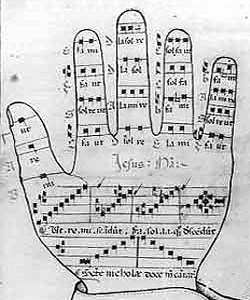This new line of inquiry corroborates my observation that only ‘views’ become dated rather that the circumstantial evidence adduced. In this case Donington has uncharacteristically made an assumption – one so fundamental indeed that it was only in the late 1970s that its own
fiction became laid to rest. That assumption was this: “
Musica Ficta = unwritten (or ‘editorial’) accidentals.” This presumption is echoed also in Reiner’s message, and was still to be found unashamedly proclaimed as late as Richard Hoppin’s
Medieval Music (1978) in the phrase “
Musica ficta (i.e. editorial accidentals)...”. It is important therefore to understand properly what those writers cited by Donington themselves understood by the two complementary terms
musica recta and
musica ficta.
It will then be seen that accidentals – both written and unwritten – of both types (
recta and
ficta) existed together, and that in consequence the application of unwritten accidentals
in itself is not any more to do with
musica ficta than with
musica recta. Moreover accidentals that are notated are mostly (though not always) examples themselves of
musica ficta rather than
recta. So having broken a false premise, it is necessary to understand exactly what both
musica ficta and
musica recta actually
are and
always had been. They are not what are proclaimed by Donington and Hoppin!
Here is a diagram of the so-called ‘Guidonian Hand’ invented in order to assist singers in the pitching of their written melodies...

This diagram contains all the recognised notes of
musica recta against each of which appear various solmisation symbols in the order: ut re mi fa sol la. The lowest note is Gamma (-ut) and this literally marks the ‘Gamut’ of the entire compass. The scale provided (extending from low G up 2.5 octaves to high D) can be read as follows: starting with the top joint of the thumb move down the thumb and then across the lowest points of the fingers; then up the little finger, and across the top joints of the remaining fingers; then down to the lowest joint of the index finger, and across the fingers to the third finger; then up to the middle joint of the third finger and across to the middle joint of the second finger. By moving through this spiral (having learnt by heart how all the pitches relate with one another) the Gamut is complete, and provides the Pythagorean diatonic scale in which the two higher Bs exist both as B-natural (B-
mi) and Bb (B-
fa). These two pitches – one flat and one natural – are therefore both
recta pitches – whether or not they may or may not be written into the music itself or merely ‘added’ by the performer ‘editorially’.
In practice, therefore, the scale can be represented upon a conventional keyboard by all the
white notes from bottom G (bottom line of the bass clef) up to top D (4th line of the treble clef), but adding also the notes Bb for the two higher positions only. (In reality the Gamut was understood to extend up a further note to E-
la-mi, but diagrams seldom bothered to include this.)
Now since what is ‘given in the hand’ is deemed to be
musica recta, it follows that all the remaining ‘fictitious’ pitches that are not indicated therein are classed as
musica ficta. Their status is in no way dependent upon whether or not they happen to be indicated in the music, or merely performed ‘editorially’. Very often they are written, and very often they are not – either way they are still
musica ficta. Obviously these ‘fictitious’ notes comprise all the missing ‘black’ notes (Eb, F#, G# Ab and so on), which despite their absence from the diatonic scale are nonetheless readily available for use whether through compulsion (i.e. to avoid unwanted dissonance) or mere desire (i.e. to decorate a melody or make it more elegant). This is where the two classes of
ficta arise:
ficta causa necessitates and
ficta causa pulchritudinis (the former being ‘necessary’ and the latter merely ‘for beauty’).
It is at this point that theoretical issues of
recta-versus-
ficta take on a new premise:
diatonic-versus-
chromatic. To what extent should a normal diatonic melody be ‘coloured’ by the use/intrusion of chromatic notes?
But this is now only the starting point for a very different line of enquiry!...
